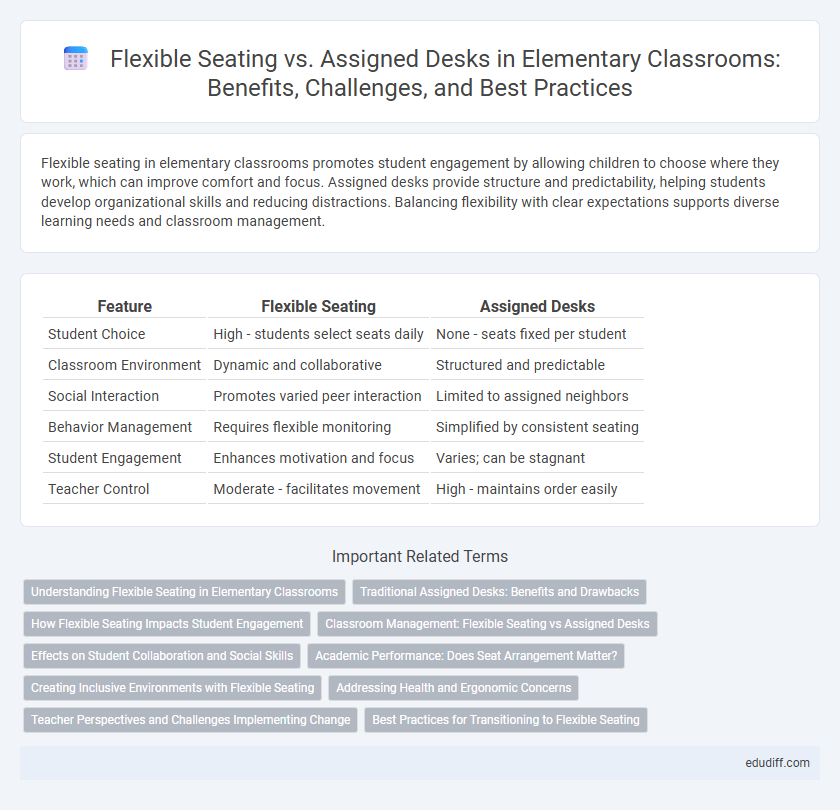Flexible seating in elementary classrooms promotes student engagement by allowing children to choose where they work, which can improve comfort and focus. Assigned desks provide structure and predictability, helping students develop organizational skills and reducing distractions. Balancing flexibility with clear expectations supports diverse learning needs and classroom management.
Table of Comparison
| Feature | Flexible Seating | Assigned Desks |
|---|---|---|
| Student Choice | High - students select seats daily | None - seats fixed per student |
| Classroom Environment | Dynamic and collaborative | Structured and predictable |
| Social Interaction | Promotes varied peer interaction | Limited to assigned neighbors |
| Behavior Management | Requires flexible monitoring | Simplified by consistent seating |
| Student Engagement | Enhances motivation and focus | Varies; can be stagnant |
| Teacher Control | Moderate - facilitates movement | High - maintains order easily |
Understanding Flexible Seating in Elementary Classrooms
Flexible seating in elementary classrooms fosters student engagement by allowing diverse seating options such as cushions, bean bags, and standing desks, which accommodate different learning styles and promote movement. This approach supports collaboration, independence, and comfort, helping students focus better compared to traditional assigned desks. Research shows that flexible seating can improve classroom behavior and increase student motivation, making it a valuable strategy in elementary education.
Traditional Assigned Desks: Benefits and Drawbacks
Traditional assigned desks in elementary classrooms provide structure and consistency, helping students develop personal responsibility and organizational skills by having a specific workspace. These desks facilitate classroom management by simplifying attendance tracking and limiting distractions in a controlled environment. However, assigned seating can reduce opportunities for collaboration and limit student mobility, potentially impacting engagement and comfort.
How Flexible Seating Impacts Student Engagement
Flexible seating in elementary classrooms boosts student engagement by allowing children to choose where and how they learn, fostering a sense of autonomy and comfort. Studies show that flexible seating options like bean bags, standing desks, and floor cushions increase participation and enthusiasm, leading to improved focus and collaboration. This adaptable environment supports diverse learning styles and helps reduce behavioral issues by empowering students to find their best learning spot.
Classroom Management: Flexible Seating vs Assigned Desks
Flexible seating in elementary classrooms fosters student autonomy and can reduce classroom disruptions by allowing movement and choice, which enhances engagement and focus. Assigned desks provide structure and predictability, simplifying behavior management and minimizing conflicts over space. Effective classroom management balances the benefits of flexible seating's dynamic environment with the stability of assigned desks to meet diverse student needs.
Effects on Student Collaboration and Social Skills
Flexible seating arrangements in elementary classrooms significantly enhance student collaboration by encouraging movement and interaction among peers, leading to improved communication and teamwork skills. Assigned desks often limit social opportunities and reduce spontaneous group work, which can hinder the development of essential social skills in young learners. Research indicates that flexible seating fosters a more dynamic learning environment, promoting cooperation and positive peer relationships.
Academic Performance: Does Seat Arrangement Matter?
Flexible seating in elementary classrooms encourages student engagement and collaboration, which has been linked to improved academic performance through increased motivation and participation. Assigned desks provide structure and predictability, benefiting students who thrive in consistent environments and minimizing distractions that can impede focus. Research indicates that the impact of seating arrangements on academic achievement varies depending on individual learning styles and classroom dynamics.
Creating Inclusive Environments with Flexible Seating
Flexible seating fosters inclusive environments by accommodating diverse learning styles and physical needs in elementary classrooms. This approach enhances student engagement and collaboration by allowing choice and movement, which supports social-emotional development and reduces behavioral issues. Research from the National Center on Universal Design for Learning shows that flexible seating improves accessibility and participation for students with different abilities.
Addressing Health and Ergonomic Concerns
Flexible seating in elementary classrooms promotes better posture and reduces musculoskeletal discomfort by offering diverse seating options like stability balls, wobble stools, and cushioned mats. Assigned desks can limit movement and contribute to stiffness or strain, potentially impacting students' focus and physical health. Incorporating ergonomic principles in flexible seating arrangements supports active engagement and overall well-being for young learners.
Teacher Perspectives and Challenges Implementing Change
Teachers in elementary classrooms often find flexible seating promotes student engagement and collaboration but face challenges in classroom management and maintaining order. Implementing flexible seating requires adjustments in routine and space organization, which can be time-consuming and demand ongoing monitoring. Many educators express concerns about addressing diverse student needs while balancing the benefits of increased mobility and comfort.
Best Practices for Transitioning to Flexible Seating
Transitioning to flexible seating in elementary classrooms requires clear expectations and routines to maintain student focus and behavior. Teachers should involve students in choosing seats, establish consistent guidelines for use, and gradually introduce new seating options to foster a comfortable learning environment. Monitoring student engagement and adjusting seating arrangements based on individual needs enhances the overall effectiveness of flexible seating implementation.
Flexible Seating vs Assigned Desks Infographic

 edudiff.com
edudiff.com